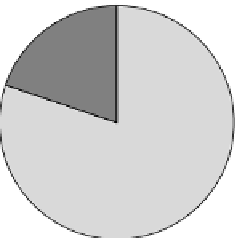Agriculture Reference
In-Depth Information
However, the case is different with Lashington because 49% of its respondents indicated
that they do manage their livestock mobility and only 22% said they do not. The rest did
not want to respond. In addition, 54% of people from Tsaba reported that they do not herd
their animals.
Fencing of rangelands
One of the major problems on the grazing lands is lack of fencing. Unfenced grazing lands
enable the non-members to utilize the resources within the rangelands without permission.
In the three communities, lack of fencing resulted in communal rangelands being misused
especially by the neighbouring villages. For example, about 86% of the respondents from
Magwiji reported that their grazing lands are not fenced and 79% of people from Lashington
reported the same case. Rangelands in Tsaba are fenced as a result; there are no threats from
the neighbouring villages. Even though rangelands are not fenced in Lashington, threats
from the neighbouring villages is not as common as in the Magwiji community with its
people complaining about this threat and indicating that this is one of the major factors that
has led to the bad condition of their rangelands. Natural landmarks are used as boundaries in
the grazing camps for rotational grazing in Lashington and Magwiji since there are no fences.
Local farmer's organisations
Farmer's organisations are important to farmers in that they act as a starting point for
joint agriculture. This is where farmers join and form associations under which they are
collectively able to market their agricultural products. In all the three study areas, there
are local farmers' organisations as shown in Figure 10.7. For example, in Magwiji, about
90% of the respondents belong to the wool association and the benefit they get from this
organisation is that it is easier and cheaper to sell their wool.
Yes
No
Figure 10.7. Distribution of farmers who belong to farmers associations.


Search WWH ::

Custom Search